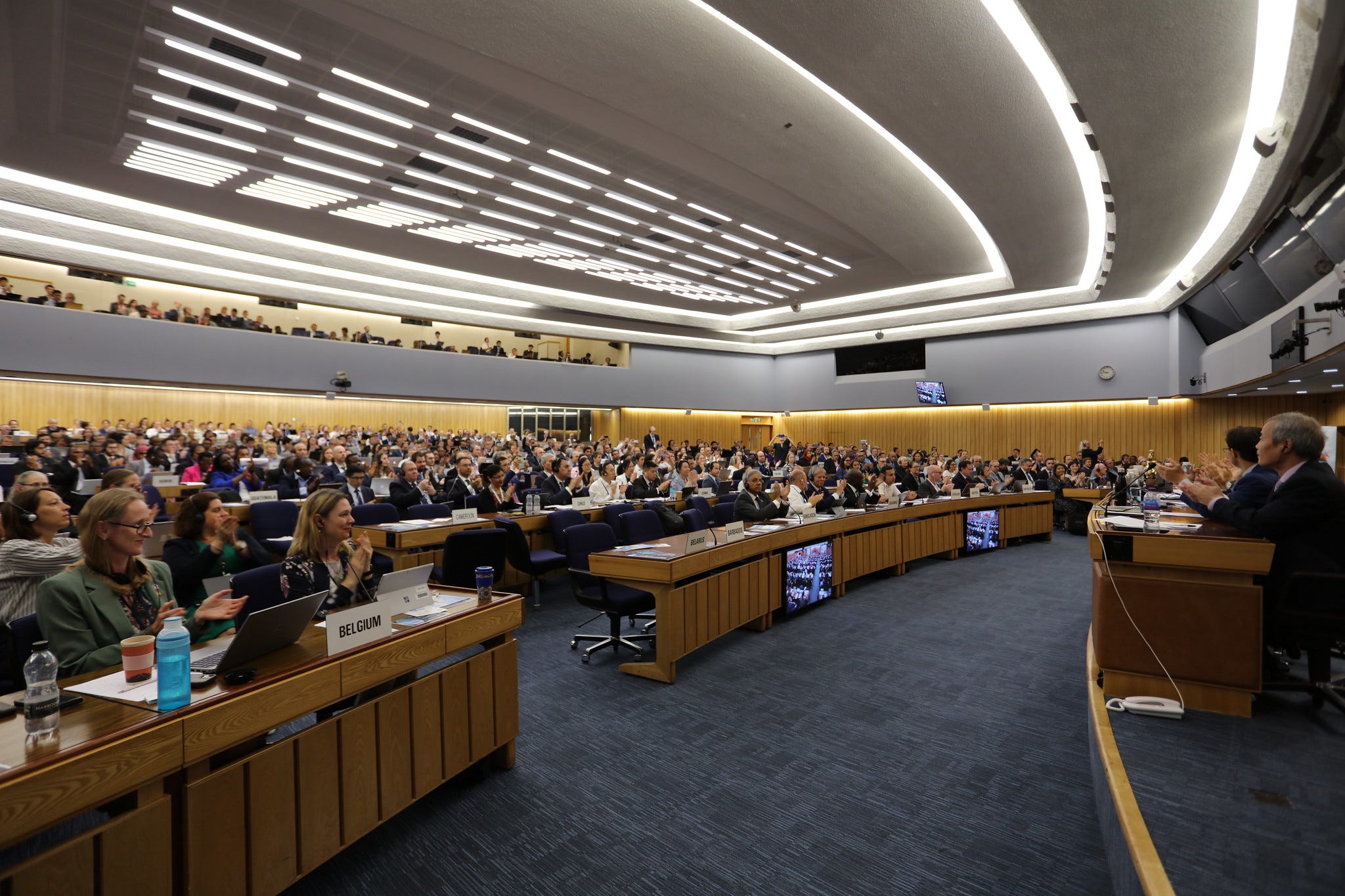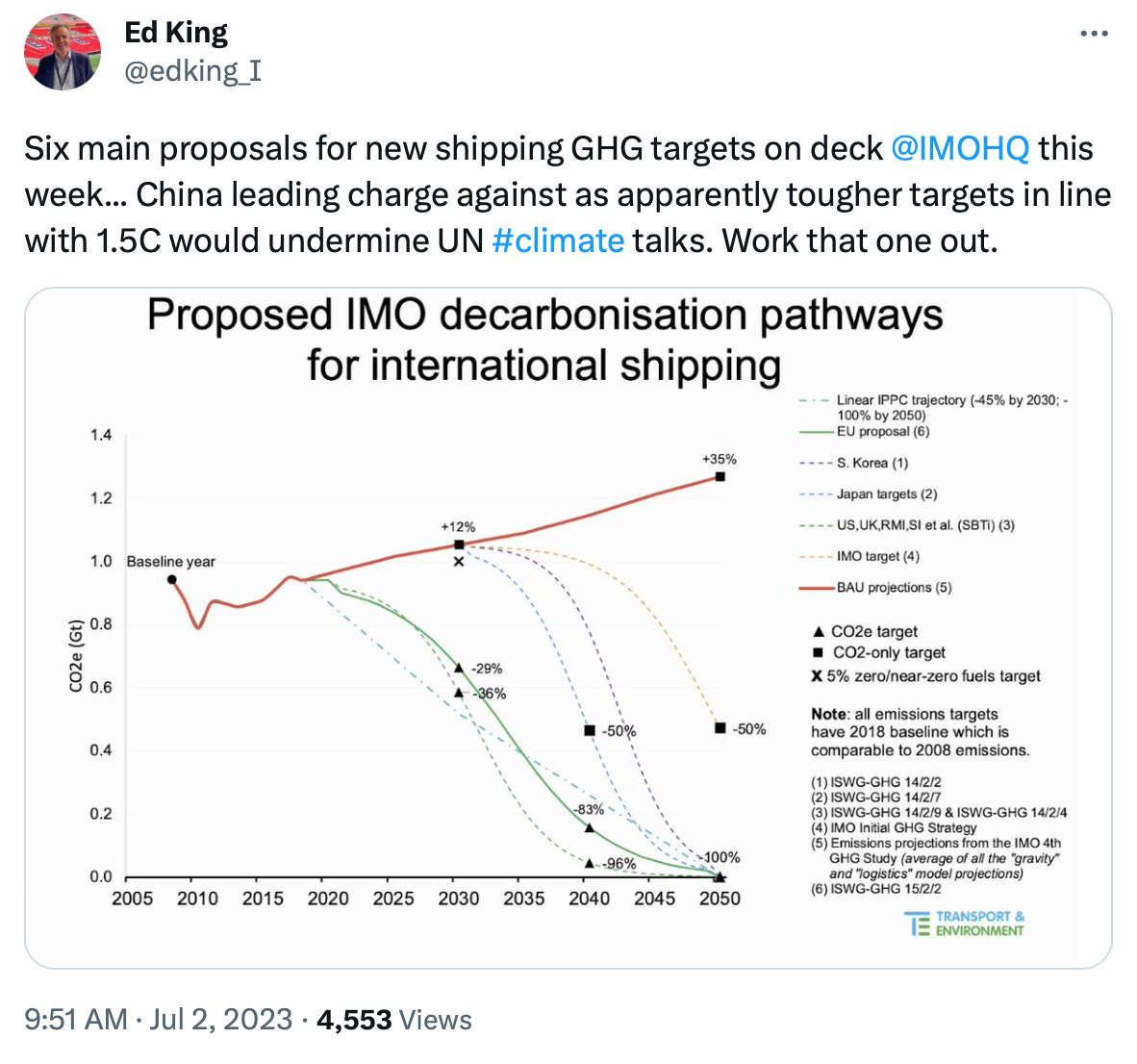A squishy agreement on ship emissions and hydrogen’s bumps in the road
Good afternoon!
Since I missed one last week, I’m doing three updates this week, today, Wednesday, and Friday. Drop me a note if there’s a topic you’d like me to address!
-Mike

The Shipping News
After a week of closed door talks, the 175 members of the United Nations’ International Maritime Organization announced its first ever carbon emissions targets – but ones that fail to meet the U.N.’s own 1.5-degree Centigrade warming target.
Emerging from negotiations in London last Friday, the IMO trumpeted plans to reach net-zero “on or about” 2050, with milestones of a 20% reduction by 2030 and 70% by 2040. Almost entirely fossil-fuel driven and notoriously difficult to regulate, global shipping is responsible for about 3% of all carbon-equivalent emissions, about the same amount as the air travel industry.

Last month at the U.N. FCCC meeting in Bonn, a growing number of countries backed the concept of a maritime carbon emissions tax. But, Simon Bennett, deputy secretary general at the International Chamber of Shipping, which represents more than 80% of the world’s merchant fleet, pointed out to Bloomberg that other than maybe sails, shipping has no fossil alternative. “2040 is less than 17 years away and the availability of zero greenhouse gas marine fuels today is virtually zero.”
Exactly how the limits would be enforced was not tackled. Many of the world’s ships are flagged by small countries such as the Marshall Islands, Panama, and Liberia.
Richer countries and small island states had called for a 50% reduction by 2030 and a 96% emissions cut by 2040, the BBC reported. But with resistance from export-dependent countries like China, Brazil, Argentina and Saudi Arabia weakened the goals, and introduced the concept of "indicative checkpoints" in 2030 and 2040 rather than hard targets.
Hydrogen’s Bumps In The Road
The basic idea behind hydrogen as a green fuel is this: It is storable, transportable, and when you burn it emits pure water as a result. For activities like power generation, fertilizer and chemical production that use methane (natural gas) as a fuel and feedstock, hydrogen can be an effective replacement requiring relatively little change to existing equipment. Aviation is also a potential hydrogen user, since the fuel is transportable.
There are a few problems with hydrogen: The first being that it is relatively low energy by volume, so you need to store it under very high pressure to have an amount that’s useful. The second being that it’s the smallest element that exists: just one electron and one proton, making it many times smaller than big, complex hydrocarbon molecules. That means microfractures in containers and pipes can easily leak.
One more problem with using hydrogen as a fuel is that other than a few test facilities around the world, not much of a supply chain exists to produce, transport or use the fuel. Yet, because it’s so promising as a carbon-free fossil-fuel replacement, the U.S. Inflation Reduction Act provides $8 billion in funding to promote and build hydrogen production hubs across the U.S. and creates uncapped tax credits that will almost put production costs at zero.
New hydrogen producers have been racing to take advantage of the generous U.S. subsidies, like a gigawatt green hydrogen project recently relocated from Europe to Michigan. The U.S. aggressive policy has steamed European policy makers, some of whom are now calling for embargos on U.S. hydrogen.
Stateside, some analysts say the American policy is too aggressive, such as a February report from a think tank led by former U.S. Energy Secretary Ernie Moniz that suggests that a lack of demand for hydrogen is the biggest barrier to creating a new market. “Boundary conditions of the energy sector make it historically slow to change,” says the report. In Europe, Spain has been encountering a similar problem as it moves to become “the Saudi Arabia of hydrogen” because potential European consumers are unwilling to invest the funds necessary to switch from methane to hydrogen.
To protect nascent American hydrogen producers, this week U.S. Department of Energy announced plans to launch a $1 billion fund that will shore up the market economics of hydrogen by supporting a price floor, ensuring hydrogen producers that they won’t lose money.
Struggles to Finance Developing Climate Mitigation
Financing developing countries for climate is winding up to be a major topic at climate negotiations in Dubai this December but there are no clear solutions on how to pay for the world to address climate change. For the rich world, it’s just a matter of raising taxes, but for developing nations, some element of rich nation support will be necessary.
Climate finance support for the developing world falls into three buckets: First, to pay for green energy conversion, second, to pay for “loss and damage” due to climate-related disasters, and third, debt relief for countries stuck in a vicious circle of decreasing tax income due to climate and increasing debt to cover shrinking economies.
Rich counties promised that by 2021 they’d pay $100 billion a year to assist with green energy conversion. But that promise was shirked up until last year, when countries came up with only $83 billion, most of which was loans. Last year rich countries agreed at the COP27 climate negotiations to loss and damage payments, but exactly how much to pay and who qualifies as a “rich nation” (e.g. is Israel “rich”? What about oil-flush Nigeria?) remains settled.
Debt resettlement has increasingly become a driving factor in climate negotiations, especially since Barbados and 130 other developing nations began pushing for the Bridgetown Initiative, which calls for expansion of multilateral lending to developing countries. Much of this comes from the Western-controlled World Bank but over the last decade China has lent around $1 trillion to developing countries through its Belt and Road Initiative. Last week U.S. Treasury Secretary Janet Yellen visited China and pressured leaders to open Sino checkbooks for debt refinancing.
Chinese foreign lending is done a bit differently than in the West. First, it’s almost always done under secret terms, so the true amount of lending and at what rate is cloudy. Second, it’s rarely funds lent directly from the Chinese Central Bank, but instead from private banks directly or indirectly controlled by the state. As a result, some private banks may not be able to afford a write down to foreign loans, potentially putting them out of business.
Finally, it seems that a large number of Chinese banks are carrying large amounts of bad debt and there remains some question as to how precarious this situation is for the nation’s economy. In other words, suffering developing nations may be propping up a good portion of the Chinese economy – but there’s no way of knowing exactly how much because everything in China is secret.
U.S. Climate Envoy John Kerry is headed to China next week to talk more about climate finance. Hopefully by then the Chinese will have found some ideas on how to reshuffle their financing schemes so the U.S. and China can make some joint announcements in Dubai this December. Meanwhile, Kerry might need another trip to the U.K. as they discuss cutting their climate aid spending.
Note: This Economist explainer on developing country green finance is a banger.
Other Things Happened
- It’s not fashionable to have a tan in China, so as there’s more heatwaves sales of “facekinis” are booming.
- China is also trying facekinis for its glaciers so they don’t melt so fast.
- Scientists are wondering if this month’s record global heat is signaling that we’ve hit a climate tipping point of no return.
- U.S. carbon emissions fell 5% last year, but global emissions are flat.
Welcome to the bottom of the newsletter! Are you on Threads? Join me there.
Thank you for reading Heat Rising. This post is public so feel free to share it.





